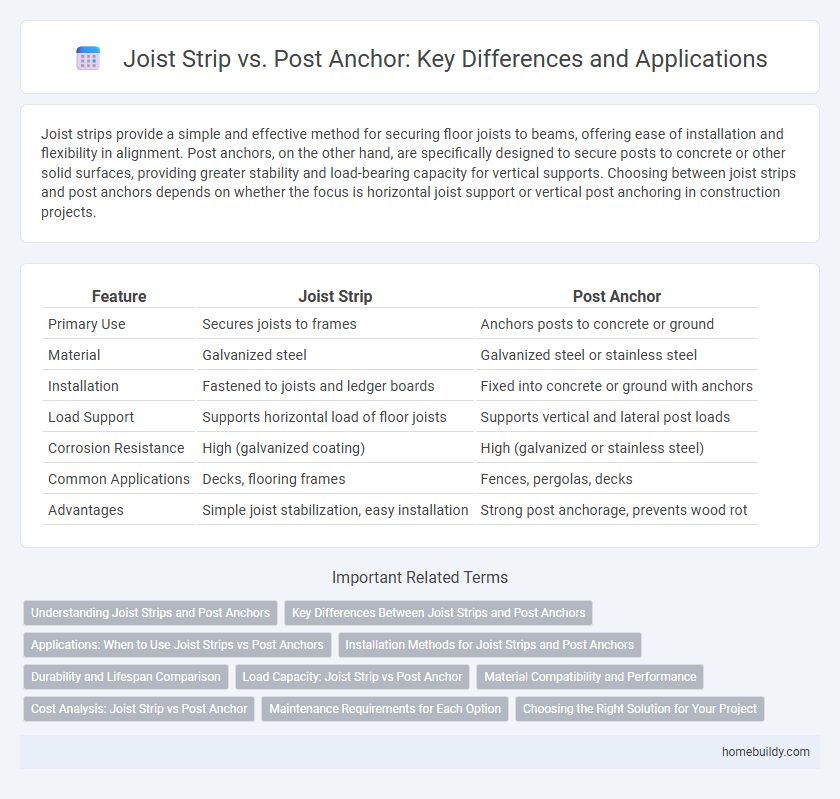Joist strips provide a simple and effective method for securing floor joists to beams, offering ease of installation and flexibility in alignment. Post anchors, on the other hand, are specifically designed to secure posts to concrete or other solid surfaces, providing greater stability and load-bearing capacity for vertical supports. Choosing between joist strips and post anchors depends on whether the focus is horizontal joist support or vertical post anchoring in construction projects.
Table of Comparison
| Feature | Joist Strip | Post Anchor |
|---|---|---|
| Primary Use | Secures joists to frames | Anchors posts to concrete or ground |
| Material | Galvanized steel | Galvanized steel or stainless steel |
| Installation | Fastened to joists and ledger boards | Fixed into concrete or ground with anchors |
| Load Support | Supports horizontal load of floor joists | Supports vertical and lateral post loads |
| Corrosion Resistance | High (galvanized coating) | High (galvanized or stainless steel) |
| Common Applications | Decks, flooring frames | Fences, pergolas, decks |
| Advantages | Simple joist stabilization, easy installation | Strong post anchorage, prevents wood rot |
Understanding Joist Strips and Post Anchors
Joist strips secure wooden joists by providing a flat metal surface for fastening, enhancing structural stability and load distribution. Post anchors, on the other hand, are designed to firmly anchor vertical posts to concrete or masonry, preventing lateral movement and uplift. Understanding the distinct functions of joist strips and post anchors is essential for selecting the right hardware to ensure proper support and longevity in construction projects.
Key Differences Between Joist Strips and Post Anchors
Joist strips secure floor joists by attaching the joist directly to the ledger board or sill plate, providing lateral stability and preventing rotation. Post anchors are designed to hold vertical posts firmly to a concrete or wooden foundation, offering strong support against uplift and lateral forces. While joist strips focus on stabilizing horizontal framing members, post anchors primarily secure vertical posts to maintain structural integrity.
Applications: When to Use Joist Strips vs Post Anchors
Joist strips are ideal for securing floor joists directly to concrete slabs, providing a sturdy connection that resists lateral movement in decking and flooring applications. Post anchors are better suited for supporting vertical posts in fences, decks, or pergolas, offering stability above ground and protecting wood from moisture damage. Use joist strips when the primary goal is to reinforce horizontal joists, and opt for post anchors when the focus is on anchoring upright posts securely.
Installation Methods for Joist Strips and Post Anchors
Joist strips install by securing directly to the ledger board and floor joists using corrosion-resistant screws or nails, ensuring strong lateral support and easy alignment. Post anchors require embedding in concrete or fastening to a solid base before affixing posts with bolts or screws, providing vertical stability and load transfer. Both methods prioritize corrosion-resistant fasteners, but joist strips allow for quicker attachment to wood framing compared to the more permanent, structural installation of post anchors.
Durability and Lifespan Comparison
Joist strips offer moderate durability, typically made from galvanized steel that resists corrosion and weathering but may wear faster in high-moisture environments compared to heavy-duty post anchors. Post anchors, often constructed from thicker steel with enhanced coatings like powder coating or stainless steel, provide superior resistance to rust and physical stress, ensuring a longer lifespan in structural applications. The lifespan of joist strips generally ranges from 10 to 20 years, whereas post anchors can last over 25 years under similar environmental conditions.
Load Capacity: Joist Strip vs Post Anchor
Joist strips provide a moderate load capacity ideal for light to medium structural support, distributing weight across a broader area of the joist. Post anchors offer higher load capacity suited for heavy-duty applications, securely anchoring vertical posts to concrete foundations. Selecting between joist strips and post anchors depends on specific load requirements and structural design demands.
Material Compatibility and Performance
Joist strips and post anchors differ significantly in material compatibility, with joist strips typically designed for wood-to-wood connections, ensuring optimal load distribution and reducing wood splitting. Post anchors, often made from galvanized steel or stainless steel, offer superior corrosion resistance, making them suitable for attaching posts to concrete bases in outdoor environments. Performance-wise, joist strips provide flexibility in framing applications, while post anchors deliver enhanced stability and durability in structural support.
Cost Analysis: Joist Strip vs Post Anchor
Joist strips generally offer a more cost-effective solution compared to post anchors due to their simpler installation and lower material expenses. Post anchors, while providing enhanced stability and support for heavier loads, tend to incur higher costs in both hardware and labor. Evaluating project requirements and budget constraints is essential to determine the most economical choice between joist strips and post anchors.
Maintenance Requirements for Each Option
Joist strips require regular inspection for corrosion and tightening of fasteners to maintain structural integrity, especially in outdoor or moist environments. Post anchors typically demand less upkeep, as they are designed to resist rust and provide stable footing with minimal adjustments over time. Proper maintenance of both ensures longevity, but joist strips generally involve more frequent attention to prevent degradation and maintain secure connections.
Choosing the Right Solution for Your Project
Joist strips provide a simple and cost-effective method for securing joists directly to beams or ledgers, ideal for light to moderate loads in decking or floor framing projects. Post anchors offer superior stability and load-bearing capacity, making them better suited for structural posts and heavy-duty applications requiring enhanced resistance to uplift and lateral forces. Selecting between joist strips and post anchors depends on project requirements such as load demands, environmental exposure, and installation complexity.
Joist strip vs Post anchor Infographic

 homebuildy.com
homebuildy.com